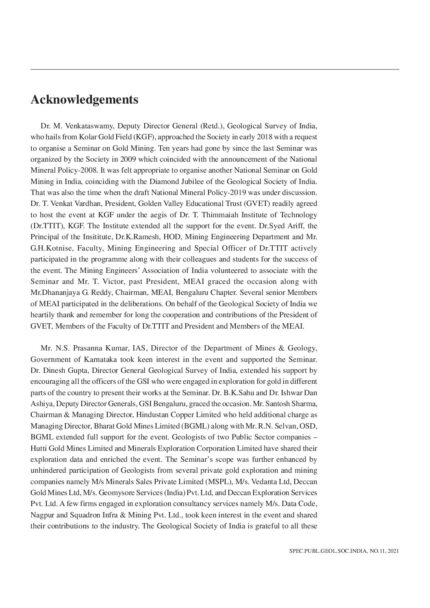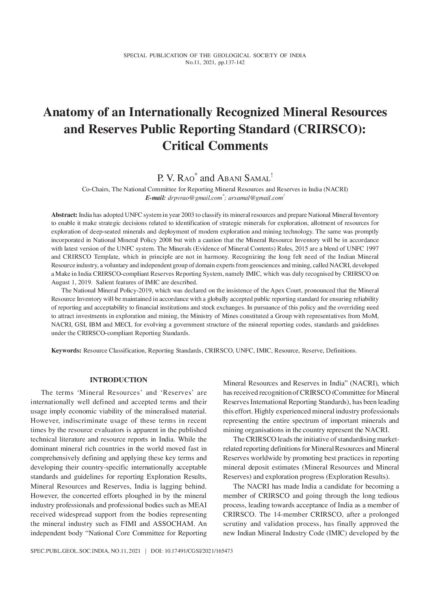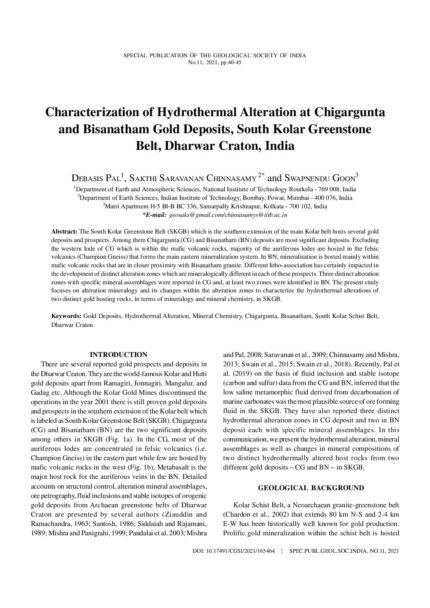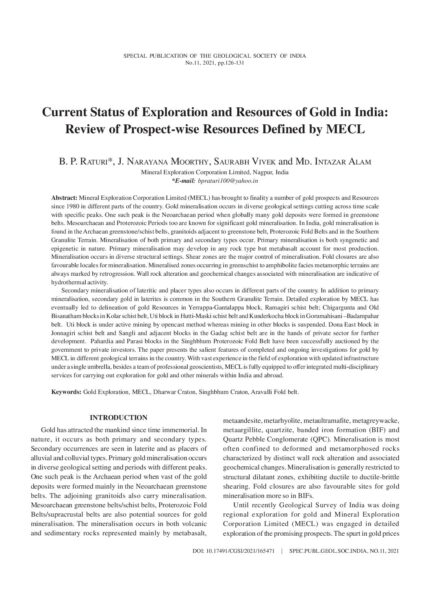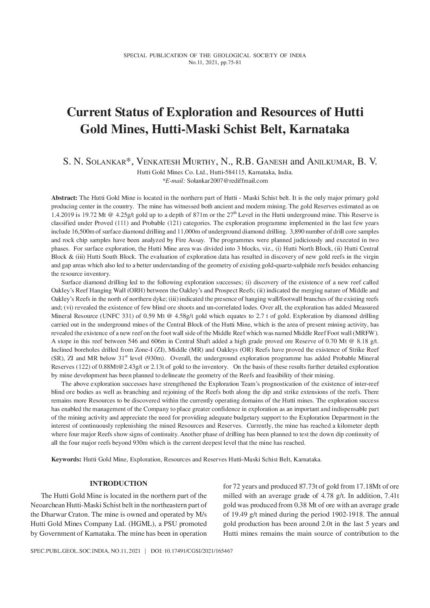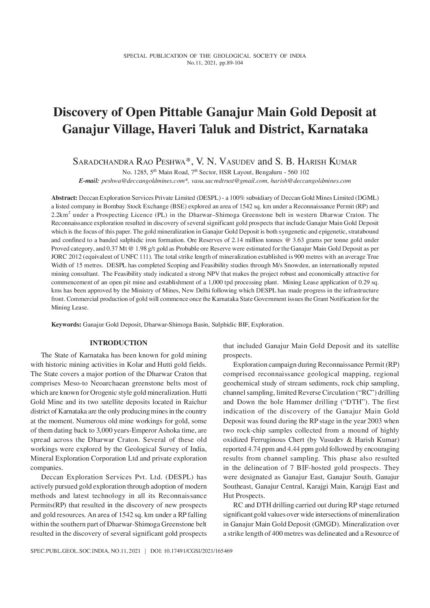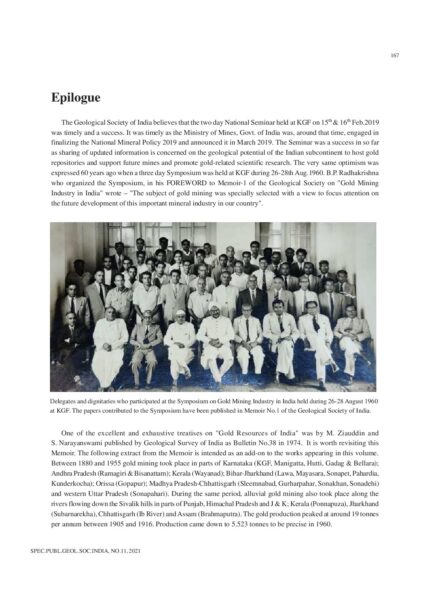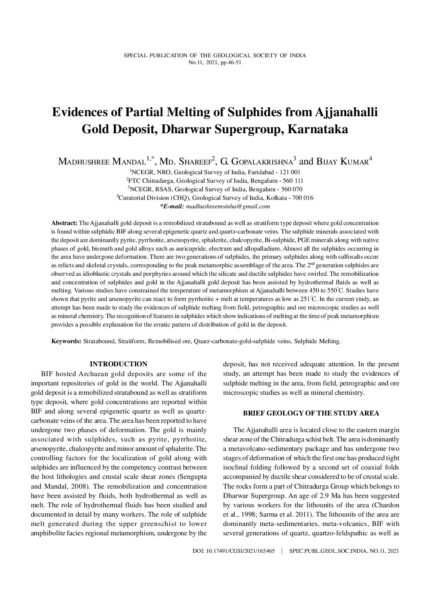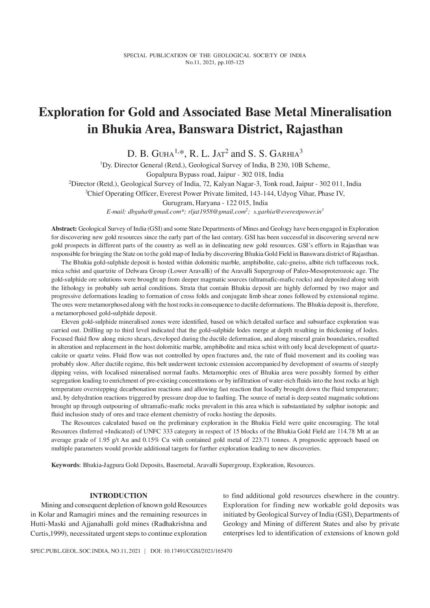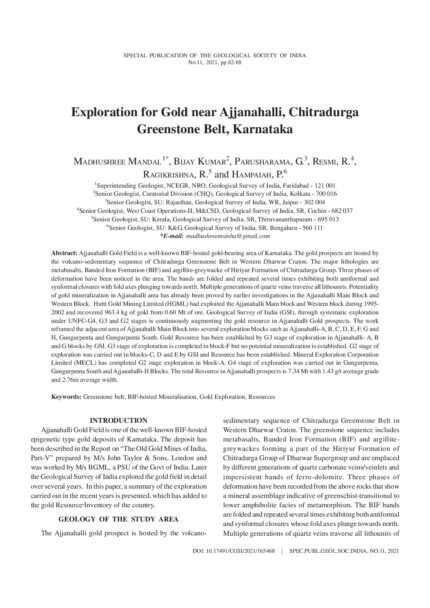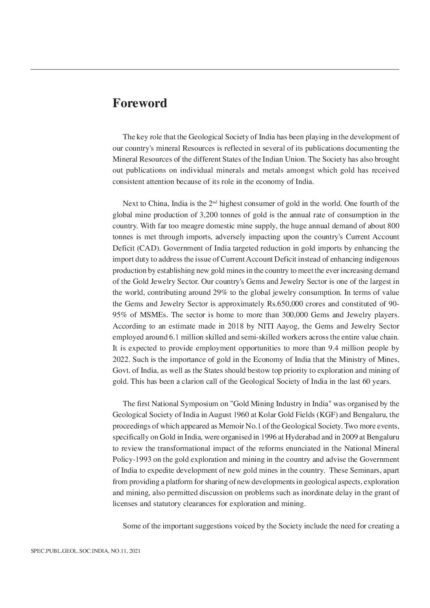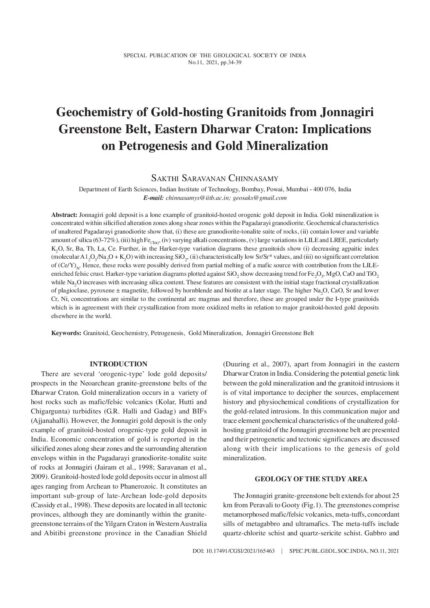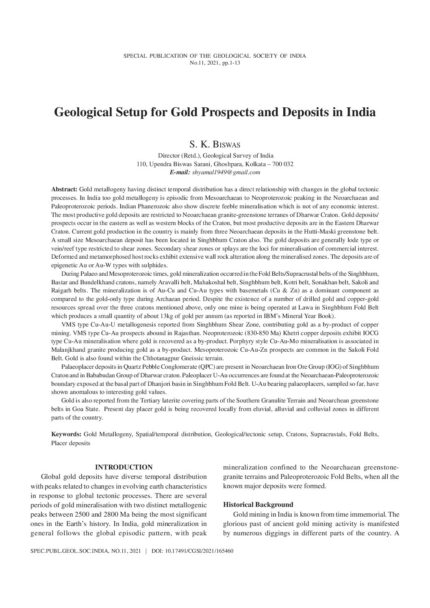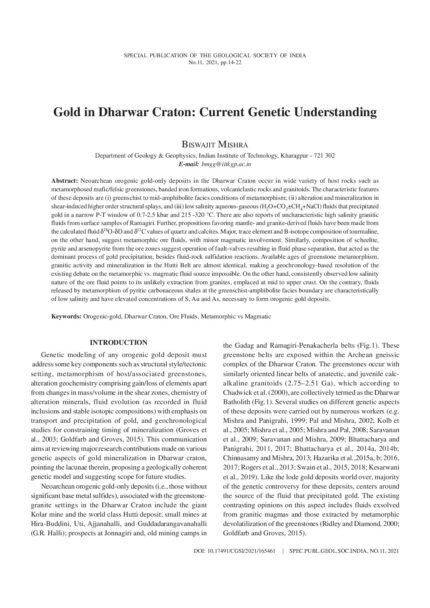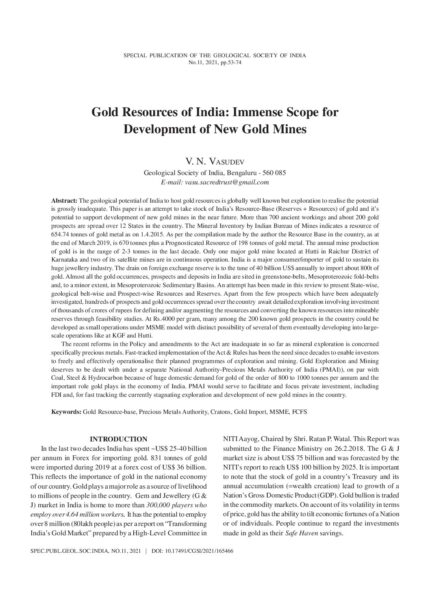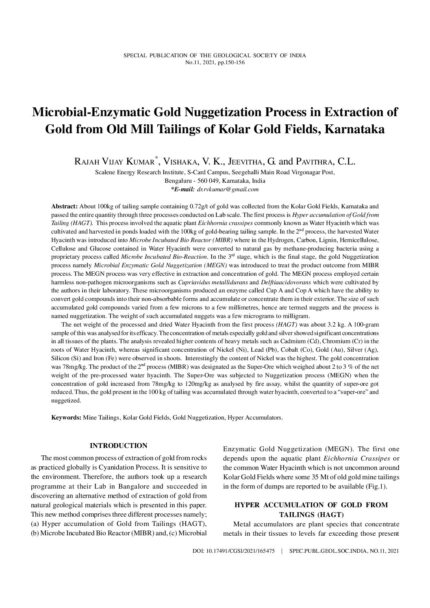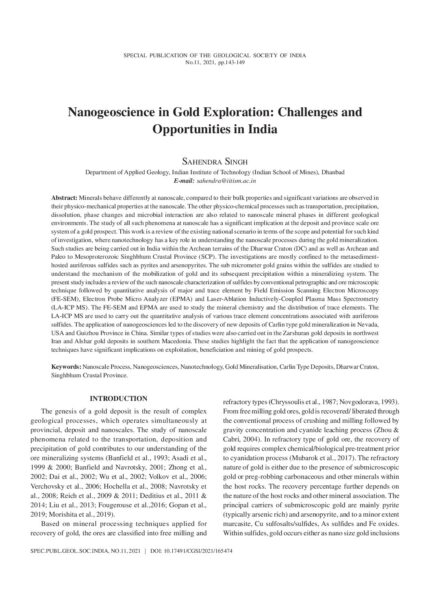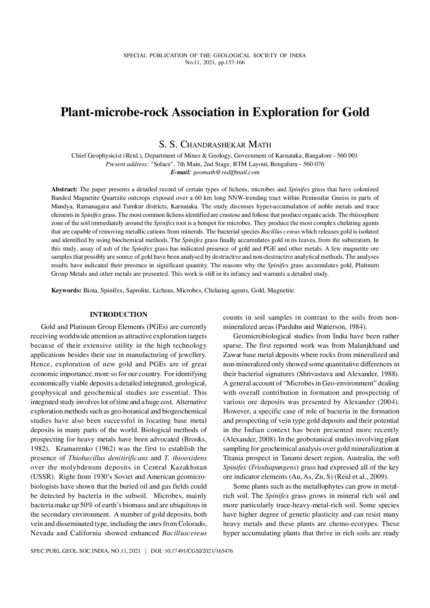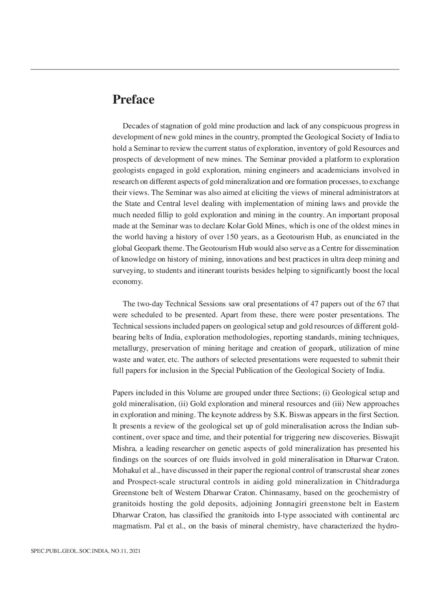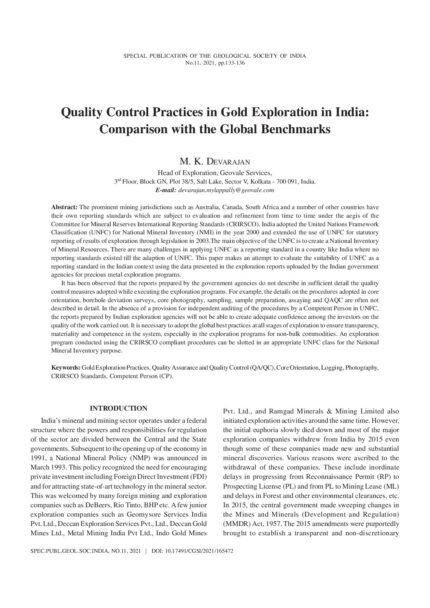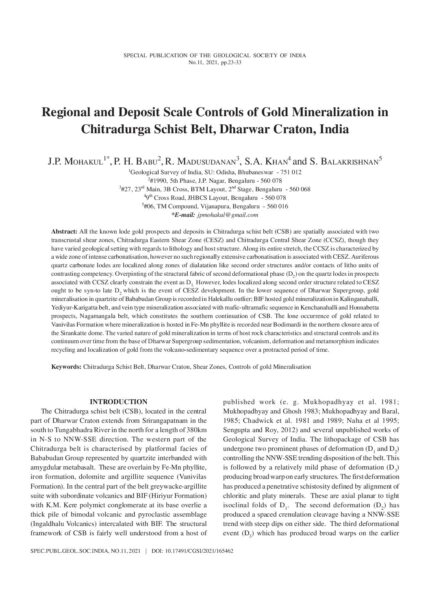SP-11: Gold Mining in India: The Way Forward
Anatomy of an Internationally Recognized Mineral Resources and Reserves Public Reporting Standard (CRIRSCO): Critical Comments
SKU:
C-165473
India has adopted UNFC system in year 2003 to classify its mineral resources and prepare National Mineral Inventory to enable it make strategic decisions related to identification of strategic minerals for exploration, allotment of resources for exploration of deep-seated minerals and deployment of modern exploration and mining technology. The same was promptly incorporated in National Mineral Policy 2008 but with a caution that the Mineral Resource Inventory will be in accordance with latest version of the UNFC system. The Minerals (Evidence of Mineral Contents) Rules, 2015 are a blend of UNFC 1997 and CRIRSCO Template, which in principle are not in harmony. Recognizing the long felt need of the Indian Mineral Resource industry, a voluntary and independent group of domain experts from geosciences and mining, called NACRI, developed a Make in India CRIRSCO-compliant Reserves Reporting System, namely IMIC, which was duly recognised by CRIRSCO on August 1, 2019. Salient features of IMIC are described.The National Mineral Policy-2019, which was declared on the insistence of the Apex Court, pronounced that the Mineral Resource Inventory will be maintained in accordance with a globally accepted public reporting standard for ensuring reliability of reporting and acceptability to financial institutions and stock exchanges. In pursuance of this policy and the overriding need to attract investments in exploration and mining, the Ministry of Mines constituted a Group with representatives from MoM, NACRI, GSI, IBM and MECL for evolving a government structure of the mineral reporting codes, standards and guidelines under the CRIRSCO-compliant Reporting Standards.
Characterization of Hydrothermal Alteration at Chigargunta and Bisanatham Gold Deposits, South Kolar Greenstone Belt, Dharwar Craton, India
SKU:
C-165464
The South Kolar Greenstone Belt (SKGB) which is the southern extension of the main Kolar belt hosts several gold deposits and prospects. Among them Chigargunta (CG) and Bisanatham (BN) deposits are most significant deposits. Excluding the western lode of CG which is within the mafic volcanic rocks, majority of the auriferous lodes are hosted in the felsic volcanics (Champion Gneiss) that forms the main eastern mineralization system. In BN, mineralisation is hosted mainly within mafic volcanic rocks that are in closer proximity with Bisanatham granite. Different litho-association has certainly impacted in the development of distinct alteration zones which are mineralogically different in each of these prospects. Three distinct alteration zones with specific mineral assemblages were reported in CG and, at least two zones were identified in BN. The present study focuses on alteration mineralogy and its changes within the alteration zones to characterize the hydrothermal alterations of two distinct gold hosting rocks, in terms of mineralogy and mineral chemistry, in SKGB.
Current Status of Exploration and Resources of Gold in India: Review of Prospect-Wise Resources Defined by MECL
SKU:
C-165471
Mineral Exploration Corporation Limited (MECL) has brought to finality a number of gold prospects and Resources since 1980 in different parts of the country. Gold mineralisation occurs in diverse geological settings cutting across time scale with specific peaks. One such peak is the Neoarchaean period when globally many gold deposits were formed in greenstone belts. Mesoarchaean and Proterozoic Periods too are known for significant gold mineralisation. In India, gold mineralisation is found in the Archaean greenstone/schist belts, granitoids adjacent to greenstone belt, Proterozoic Fold Belts and in the Southern Granulite Terrain. Mineralisation of both primary and secondary types occur. Primary mineralisation is both syngenetic and epigenetic in nature. Primary mineralisation may develop in any rock type but metabasalt account for most production. Mineralisation occurs in diverse structural settings. Shear zones are the major control of mineralisation. Fold closures are also favourable locales for mineralisation. Mineralised zones occurring in greenschist to amphibolite facies metamorphic terrains are always marked by retrogression. Wall rock alteration and geochemical changes associated with mineralisation are indicative of hydrothermal activity.Secondary mineralisation of lateritic and placer types also occurs in different parts of the country. In addition to primary mineralisation, secondary gold in laterites is common in the Southern Granulite Terrain. Detailed exploration by MECL has eventually led to delineation of gold Resources in Yerrappa-Gantalappa block, Ramagiri schist belt; Chigargunta and Old Bisanatham blocks in Kolar schist belt, Uti block in Hutti-Maski schist belt and Kunderkocha block in Gorumahisani ?Badampahar belt. Uti block is under active mining by opencast method whereas mining in other blocks is suspended. Dona East block in Jonnagiri schist belt and Sangli and adjacent blocks in the Gadag schist belt are in the hands of private sector for further development. Pahardia and Parasi blocks in the Singhbhum Proterozoic Fold Belt have been successfully auctioned by the government to private investors. The paper presents the salient features of completed and ongoing investigations for gold by MECL in different geological terrains in the country. With vast experience in the field of exploration with updated infrastructure under a single umbrella, besides a team of professional geoscientists, MECL is fully equipped to offer integrated multi-disciplinary services for carrying out exploration for gold and other minerals within India and abroad.
Current Status of Exploration and Resources of Hutti Gold Mines, Hutti-Maski Schist Belt, Karnataka
SKU:
C-165467
The Hutti Gold Mine is located in the northern part of Hutti - Maski Schist belt. It is the only major primary gold producing center in the country. The mine has witnessed both ancient and modern mining. The gold Reserves estimated as on 1.4.2019 is 19.72 Mt @ 4.25g/t gold up to a depth of 871m or the 27th Level in the Hutti underground mine. This Reserve is classified under Proved (111) and Probable (121) categories. The exploration programme implemented in the last few years include 16,500m of surface diamond drilling and 11,000m of underground diamond drilling. 3,890 number of drill core samples and rock chip samples have been analyzed by Fire Assay. The programmes were planned judiciously and executed in two phases. For surface exploration, the Hutti Mine area was divided into 3 blocks, viz., (i) Hutti North Block, (ii) Hutti Central Block & (iii) Hutti South Block. The evaluation of exploration data has resulted in discovery of new gold reefs in the virgin and gap areas which also led to a better understanding of the geometry of existing gold-quartz-sulphide reefs besides enhancing the resource inventory.Surface diamond drilling led to the following exploration successes; (i) discovery of the existence of a new reef called Oakley?s Reef Hanging Wall (ORH) between the Oakley?s and Prospect Reefs; (ii) indicated the merging nature of Middle and Oakley?s Reefs in the north of northern dyke; (iii) indicated the presence of hanging wall/footwall branches of the existing reefs and; (vi) revealed the existence of few blind ore shoots and un-correlated lodes. Over all, the exploration has added Measured Mineral Resource (UNFC 331) of 0.59 Mt @ 4.58g/t gold which equates to 2.7 t of gold. Exploration by diamond drilling carried out in the underground mines of the Central Block of the Hutti Mine, which is the area of present mining activity, has revealed the existence of a new reef on the foot wall side of the Middle Reef which was named Middle Reef Foot wall (MRFW). A stope in this reef between 546 and 606m in Central Shaft added a high grade proved ore Reserve of 0.70 Mt @ 8.18 g/t. Inclined boreholes drilled from Zone-I (ZI), Middle (MR) and Oakleys (OR) Reefs have proved the existence of Strike Reef (SR), ZI and MR below 31st level (930m). Overall, the underground exploration programme has added Probable Mineral Reserves (122) of 0.88Mt@2.43g/t or 2.13t of gold to the inventory. On the basis of these results further detailed exploration by mine development has been planned to delineate the geometry of the Reefs and feasibility of their mining.The above exploration successes have strengthened the Exploration Team?s prognostication of the existence of inter-reef blind ore bodies as well as branching and rejoining of the Reefs both along the dip and strike extensions of the reefs. There remains more Resources to be discovered within the currently operating domains of the Hutti mines. The exploration success has enabled the management of the Company to place greater confidence in exploration as an important and indispensable part of the mining activity and appreciate the need for providing adequate budgetary support to the Exploration Department in the interest of continuously replenishing the mined Resources and Reserves. Currently, the mine has reached a kilometer depth where four major Reefs show signs of continuity. Another phase of drilling has been planned to test the down dip continuity of all the four major reefs beyond 930m which is the current deepest level that the mine has reached.
Evidences of Partial Melting of Sulphides from Ajjanahalli Gold Deposit, Dharwar Supergroup, Karnataka
SKU:
C-165465
The Ajjanahalli gold deposit is a remobilized stratabound as well as stratiform type deposit where gold concentration is found within sulphidic BIF along several epigenetic quartz and quartz-carbonate veins. The sulphide minerals associated with the deposit are dominantly pyrite, pyrrhotite, arsenopyrite, sphalerite, chalcopyrite, Bi-sulphide, PGE minerals along with native phases of gold, bismuth and gold alloys such as auricupride, electrum and allopalladium. Almost all the sulphides occurring in the area have undergone deformation. There are two generations of sulphides, the primary sulphides along with sulfosalts occur as relicts and skeletal crystals, corresponding to the peak metamorphic assemblage of the area. The 2nd generation sulphides are observed as idioblastic crystals and porphyries around which the silicate and ductile sulphides have swirled. The remobilization and concentration of sulphides and gold in the Ajjanahalli gold deposit has been assisted by hydrothermal fluids as well as melting. Various studies have constrained the temperature of metamorphism at Ajjanahalli between 450 to 550?C. Studies have shown that pyrite and arsenopyrite can react to form pyrrhotite + melt at temperatures as low as 251?C. In the current study, an attempt has been made to study the evidences of sulphide melting from field, petrographic and ore microscopic studies as well as mineral chemistry. The recognition of features in sulphides which show indications of melting at the time of peak metamorphism provides a possible explanation for the erratic pattern of distribution of gold in the deposit.
Exploration for Gold near Ajjanahalli, Chitradurga Greenstone Belt, Karnataka
SKU:
C-165468
Ajjanahalli Gold Field is a well-known BIF-hosted gold-bearing area of Karnataka. The gold prospects are hosted by the volcano-sedimentary sequence of Chitradurga Greenstone Belt in Western Dharwar Craton. The major lithologies are metabasalts, Banded Iron Formation (BIF) and argillite-greywacke of Hiriyur Formation of Chitradurga Group. Three phases of deformation have been noticed in the area. The bands are folded and repeated several times exhibiting both antiformal and synformal closures with fold axes plunging towards north. Multiple generations of quartz veins traverse all lithounits. Potentiality of gold mineralization in Ajjanahalli area has already been proved by earlier investigations in the Ajjanahalli Main Block and Western Block. Hutti Gold Mining Limited (HGML) had exploited the Ajjanahalli Main block and Western block during 1995- 2002 and recovered 963.4 kg of gold from 0.60 Mt of ore. Geological Survey of India (GSI), through systematic exploration under UNFC-G4, G3 and G2 stages is continuously augmenting the gold resource in Ajjanahalli Gold prospects. The work reframed the adjacent area of Ajjanahalli Main Block into several exploration blocks such as Ajjanahalli-A, B, C, D, E, F, G and H, Gungurpenta and Gungurpenta South. Gold Resource has been established by G3 stage of exploration in Ajjanahalli-A, B and G blocks by GSI. G3 stage of exploration is completed in block-F but no potential mineralization is established. G2 stage of exploration was carried out in blocks-C, D and E by GSI and Resource has been established. Mineral Exploration Corporation Limited (MECL) has completed G2 stage exploration in block-A. G4 stage of exploration was carried out in Gungurpenta, Gungurpenta South and Ajjanahalli-H Blocks. The total Resource in Ajjanahalli prospects is 7.34 Mt with 1.43 g/t average grade and 2.76m average width.
Geochemistry of Gold-Hosting Granitoids from Jonnagiri Greenstone Belt, Eastern Dharwar Craton: Implications on Petrogenesis and Gold Mineralization
SKU:
C-165463
Jonnagiri gold deposit is a lone example of granitoid-hosted orogenic gold deposit in India. Gold mineralization is concentrated within silicified alteration zones along shear zones within the Pagadarayi granodiorite. Geochemical characteristics of unaltered Pagadarayi granodiorite show that, (i) these are granodiorite-tonalite suite of rocks, (ii) contain lower and variable amount of silica (63-72%), (iii) high Fe(Tot), (iv) varying alkali concentrations, (v) large variations in LILE and LREE, particularly K2O, Sr, Ba, Th, La, Ce. Further, in the Harker-type variation diagrams these granitoids show (i) decreasing agpaitic index (molecular Al2O3/Na2O + K2O) with increasing SiO2, (ii) characteristically low Sr/Sr* values, and (iii) no significant correlation of (Ce/Y)N. Hence, these rocks were possibly derived from partial melting of a mafic source with contribution from the LILE-enriched felsic crust. Harker-type variation diagrams plotted against SiO2 show decreasing trend for Fe2O3, MgO, CaO and TiO2 while Na2O increases with increasing silica content. These features are consistent with the initial stage fractional crystallization of plagioclase, pyroxene ? magnetite, followed by hornblende and biotite at a later stage. The higher Na2O, CaO, Sr and lower Cr, Ni, concentrations are similar to the continental arc magmas and therefore, these are grouped under the I-type granitoids which is in agreement with their crystallization from more oxidized melts in relation to major granitoid-hosted gold deposits elsewhere in the world.
Geological Setup for Gold Prospects and Deposits in India
SKU:
C-165460
Gold metallogeny having distinct temporal distribution has a direct relationship with changes in the global tectonic processes. In India too gold metallogeny is episodic from Mesoarchaean to Neoproterozoic peaking in the Neoarchaean and Paleoproterozoic periods. Indian Phanerozoic also show discrete feeble mineralisation which is not of any economic interest. The most productive gold deposits are restricted to Neoarchaean granite-greenstone terranes of Dharwar Craton. Gold deposits/ prospects occur in the eastern as well as western blocks of the Craton, but most productive deposits are in the Eastern Dharwar Craton. Current gold production in the country is mainly from three Neoarchaean deposits in the Hutti-Maski greenstone belt. A small size Mesoarchaean deposit has been located in Singhbhum Craton also. The gold deposits are generally lode type or vein/reef type restricted to shear zones. Secondary shear zones or splays are the loci for mineralisation of commercial interest. Deformed and metamorphosed host rocks exhibit extensive wall rock alteration along the mineralised zones. The deposits are of epigenetic Au or Au-W types with sulphides.During Palaeo and Mesoproterozoic times, gold mineralization occurred in the Fold Belts/Supracrustal belts of the Singhbhum, Bastar and Bundelkhand cratons, namely Aravalli belt, Mahakoshal belt, Singhbhum belt, Kotri belt, Sonakhan belt, Sakoli and Raigarh belts. The mineralization is of Au-Cu and Cu-Au types with basemetals (Cu & Zn) as a dominant component as compared to the gold-only type during Archaean period. Despite the existence of a number of drilled gold and copper-gold resources spread over the three cratons mentioned above, only one mine is being operated at Lawa in Singhbhum Fold Belt which produces a small quantity of about 13kg of gold per annum (as reported in IBM?s Mineral Year Book).VMS type Cu-Au-U metallogenesis reported from Singhbhum Shear Zone, contributing gold as a by-product of copper mining. VMS type Cu-Au prospects abound in Rajasthan. Neoproterozoic (830-850 Ma) Khetri copper deposits exhibit IOCG type Cu-Au mineralisation where gold is recovered as a by-product. Porphyry style Cu-Au-Mo mineralisation is associated in Malanjkhand granite producing gold as a by-product. Mesoproterozoic Cu-Au-Zn prospects are common in the Sakoli Fold Belt. Gold is also found within the Chhotanagpur Gneissic terrain.Palaeoplacer deposits in Quartz Pebble Conglomerate (QPC) are present in Neoarchaean Iron Ore Group (IOG) of Singhbhum Craton and in Bababudan Group of Dharwar craton. Paleoplacer U-Au occurrences are found at the Neoarchaean-Paleoproterozoic boundary exposed at the basal part of Dhanjori basin in Singhbhum Fold Belt. U-Au bearing palaeoplacers, sampled so far, have shown anomalous to interesting gold valuesGold is also reported from the Tertiary laterite covering parts of the Southern Granulite Terrain and Neoarchean greenstone belts in Goa State. Present day placer gold is being recovered locally from eluvial, alluvial and colluvial zones in different parts of the country.
Gold in Dharwar Craton: Current Genetic Understanding
SKU:
C-165461
Neoarchean orogenic gold-only deposits in the Dharwar Craton occur in wide variety of host rocks such as metamorphosed mafic/felsic greenstones, banded iron formations, volcaniclastic rocks and granitoids. The characteristic features of these deposits are (i) greenschist to mid-amphibolite facies conditions of metamorphism; (ii) alteration and mineralization in shear-induced higher order structural splays, and (iii) low salinity aqueous-gaseous (H2O+CO2?CH4+NaCl) fluids that precipitated gold in a narrow P-T window of 0.7-2.5 kbar and 215-320 ?C. There are also reports of uncharacteristic high salinity granitic fluids from surface samples of Ramagiri. Further, propositions favoring mantle- and granite-derived fluids have been made from the calculated fluid ?18O-?D and ?13C values of quartz and calcites. Major, trace element and B-isotope composition of tourmaline, on the other hand, suggest metamorphic ore fluids, with minor magmatic involvement. Similarly, composition of scheelite, pyrite and arsenopyrite from the ore zones suggest operation of fault-valves resulting in fluid phase separation, that acted as the dominant process of gold precipitation, besides fluid-rock sulfidation reactions. Available ages of greenstone metamorphism, granitic activity and mineralization in the Hutti Belt are almost identical, making a geochronology-based resolution of the existing debate on the metamorphic vs. magmatic fluid source impossible. On the other hand, consistently observed low salinity nature of the ore fluid points to its unlikely extraction from granites, emplaced at mid to upper crust. On the contrary, fluids released by metamorphism of pyritic carbonaceous shales at the greenschist-amphibolite facies boundary are characteristically of low salinity and have elevated concentrations of S, Au and As, necessary to form orogenic gold deposits.
Gold Resources of India: Immense Scope for Development of New Gold Mines
SKU:
C-165466
The geological potential of India to host gold resources is globally well known but exploration to realise the potential is grossly inadequate. This paper is an attempt to take stock of India?s Resource-Base (Reserves + Resources) of gold and it?s potential to support development of new gold mines in the near future. More than 700 ancient workings and about 200 gold prospects are spread over 12 States in the country. The Mineral Inventory by Indian Bureau of Mines indicates a resource of 654.74 tonnes of gold metal as on 1.4.2015. As per the compilation made by the author the Resource Base in the country, as at the end of March 2019, is 670 tonnes plus a Prognosticated Resource of 198 tonnes of gold metal. The annual mine production of gold is in the range of 2-3 tonnes in the last decade. Only one major gold mine located at Hutti in Raichur District of Karnataka and two of its satellite mines are in continuous operation. India is a major consumer/importer of gold to sustain its huge jewellery industry. The drain on foreign exchange reserve is to the tune of 40 billion US$ annually to import about 800t of gold. Almost all the gold occurrences, prospects and deposits in India are sited in greenstone-belts, Mesoproterozoic fold-belts and, to a minor extent, in Mesoproterozoic Sedimentary Basins. An attempt has been made in this review to present State-wise, geological belt-wise and Prospect-wise Resources and Reserves. Apart from the few prospects which have been adequately investigated, hundreds of prospects and gold occurrences spread over the country await detailed exploration involving investment of thousands of crores of rupees for defining and/or augmenting the resources and converting the known resources into mineable reserves through feasibility studies. At Rs.4000 per gram, many among the 200 known gold prospects in the country could be developed as small operations under MSME model with distinct possibility of several of them eventually developing into largescale operations like at KGF and Hutti.The recent reforms in the Policy and amendments to the Act are inadequate in so far as mineral exploration is concerned specifically precious metals. Fast-tracked implementation of the Act & Rules has been the need since decades to enable investors to freely and effectively operationalise their planned programmes of exploration and mining. Gold Exploration and Mining deserves to be dealt with under a separate National Authority-Precious Metals Authority of India (PMAI)), on par with Coal, Steel & Hydrocarbon because of huge domestic demand for gold of the order of 800 to 1000 tonnes per annum and the important role gold plays in the economy of India. PMAI would serve to facilitate and focus private investment, including FDI and, for fast tracking the currently stagnating exploration and development of new gold mines in the country.
Microbial-Enzymatic Gold Nuggetization Process in Extraction of Gold from Old Mill Tailings of Kolar Gold Fields, Karnataka
SKU:
C-165475
About 100kg of tailing sample containing 0.72g/t of gold was collected from the Kolar Gold Fields, Karnataka and passed the entire quantity through three processes conducted on Lab scale. The first process is Hyper accumulation of Gold from Tailing (HAGT). This process involved the aquatic plant Eichhornia crassipes commonly known as Water Hyacinth which was cultivated and harvested in ponds loaded with the 100kg of gold-bearing tailing sample. In the 2nd process, the harvested Water Hyacinth was introduced into Microbe Incubated Bio Reactor (MIBR) where in the Hydrogen, Carbon, Lignin, Hemicellulose, Cellulose and Glucose contained in Water Hyacinth were converted to natural gas by methane-producing bacteria using a proprietary process called Microbe Incubated Bio-Reaction. In the 3rd stage, which is the final stage, the gold Nuggetization process namely Microbial Enzymatic Gold Nuggetization (MEGN) was introduced to treat the product outcome from MIBR process. The MEGN process was very effective in extraction and concentration of gold. The MEGN process employed certain harmless non-pathogen microorganisms such as Cupriavidus metallidurans and Delftiaacidovorans which were cultivated by the authors in their laboratory. These microorganisms produced an enzyme called Cup A and Cop A which have the ability to convert gold compounds into their non-absorbable forms and accumulate or concentrate them in their exterior. The size of such accumulated gold compounds varied from a few microns to a few millimetres, hence are termed nuggets and the process is named nuggetization. The weight of such accumulated nuggets was a few micrograms to milligram.The net weight of the processed and dried Water Hyacinth from the first process (HAGT) was about 3.2 kg. A 100-gram sample of this was analysed for its efficacy. The concentration of metals especially gold and silver showed significant concentrations in all tissues of the plants. The analysis revealed higher contents of heavy metals such as Cadmium (Cd), Chromium (Cr) in the roots of Water Hyacinth, whereas significant concentration of Nickel (Ni), Lead (Pb), Cobalt (Co), Gold (Au), Silver (Ag), Silicon (Si) and Iron (Fe) were observed in shoots. Interestingly the content of Nickel was the highest. The gold concentration was 78mg/kg. The product of the 2nd process (MIBR) was designated as the Super-Ore which weighed about 2 to 3 % of the net weight of the pre-processed water hyacinth. The Super-Ore was subjected to Nuggetization process (MEGN) when the concentration of gold increased from 78mg/kg to 120mg/kg as analysed by fire assay, whilst the quantity of super-ore got reduced. Thus, the gold present in the 100 kg of tailing was accumulated through water hyacinth, converted to a ?super-ore? and nuggetized.
Nanogeoscience in Gold Exploration: Challenges and Opportunities in India
SKU:
C-165474
Minerals behave differently at nanoscale, compared to their bulk properties and significant variations are observed in their physico-mechanical properties at the nanoscale. The other physico-chemical processes such as transportation, precipitation, dissolution, phase changes and microbial interaction are also related to nanoscale mineral phases in different geological environments. The study of all such phenomena at nanoscale has a significant implication at the deposit and province scale ore system of a gold prospect. This work is a review of the existing national scenario in terms of the scope and potential for such kind of investigation, where nanotechnology has a key role in understanding the nanoscale processes during the gold mineralization. Such studies are being carried out in India within the Archean terrains of the Dharwar Craton (DC) and as well as Archean and Paleo to Mesoproterozoic Singhbhum Crustal Province (SCP). The investigations are mostly confined to the metasedimenthosted auriferous sulfides such as pyrites and arsenopyrites. The sub micrometer gold grains within the sulfides are studied to understand the mechanism of the mobilization of gold and its subsequent precipitation within a mineralizing system. The present study includes a review of the such nanoscale characterization of sulfides by conventional petrographic and ore microscopic technique followed by quantitative analysis of major and trace element by Field Emission Scanning Electron Microscopy (FE-SEM), Electron Probe Micro Analyzer (EPMA) and Laser-Ablation Inductively-Coupled Plasma Mass Spectrometry (LA-ICP MS). The FE-SEM and EPMA are used to study the mineral chemistry and the distribution of trace elements. The LA-ICP MS are used to carry out the quantitative analysis of various trace element concentrations associated with auriferous sulfides. The application of nanogeosciences led to the discovery of new deposits of Carlin type gold mineralization in Nevada, USA and Guizhou Province in China. Similar types of studies were also carried out in the Zarshuran gold deposits in northwest Iran and Alshar gold deposits in southern Macedonia. These studies highlight the fact that the application of nanogeoscience techniques have significant implications on exploitation, beneficiation and mining of gold prospects.
Plant-Microbe-Rock Association in Exploration for Gold
SKU:
C-165476
The paper presents a detailed record of certain types of lichens, microbes and Spinifex grass that have colonized Banded Magnetite Quartzite outcrops exposed over a 60 km long NNW-trending tract within Peninsular Gneiss in parts of Mandya, Ramanagara and Tumkur districts, Karnataka. The study discusses hyper-accumulation of noble metals and trace elements in Spinifex grass. The most common lichens identified are crustose and foliose that produce organic acids. The rhizosphere zone of the soil immediately around the Spinifex root is a hotspot for microbes. They produce the most complex chelating agents that are capable of removing metallic cations from minerals. The bacterial species Bacillus cereus which releases gold is isolated and identified by using biochemical methods. The Spinifex grass finally accumulates gold in its leaves, from the substratum. In this study, assay of ash of the Spinifex grass has indicated presence of gold and PGE and other metals. A few magnetite ore samples that possibly are source of gold have been analysed by destructive and non-destructive analytical methods. The analyses results have indicated their presence in significant quantity. The reasons why the Spinifex grass accumulates gold, Platinum Group Metals and other metals are presented. This work is still in its infancy and warrants a detailed study.
Quality Control Practices in Gold Exploration in India: Comparison with the Global Benchmarks
SKU:
C-165472
The prominent mining jurisdictions such as Australia, Canada, South Africa and a number of other countries have their own reporting standards which are subject to evaluation and refinement from time to time under the aegis of the Committee for Mineral Reserves International Reporting Standards (CRIRSCO). India adopted the United Nations Framework Classification (UNFC) for National Mineral Inventory (NMI) in the year 2000 and extended the use of UNFC for statutory reporting of results of exploration through legislation in 2003.The main objective of the UNFC is to create a National Inventory of Mineral Resources. There are many challenges in applying UNFC as a reporting standard in a country like India where no reporting standards existed till the adaption of UNFC. This paper makes an attempt to evaluate the suitability of UNFC as a reporting standard in the Indian context using the data presented in the exploration reports uploaded by the Indian government agencies for precious metal exploration programs.It has been observed that the reports prepared by the government agencies do not describe in sufficient detail the quality control measures adopted while executing the exploration programs. For example, the details on the procedures adopted in core orientation, borehole deviation surveys, core photography, sampling, sample preparation, assaying and QAQC are often not described in detail. In the absence of a provision for independent auditing of the procedures by a Competent Person in UNFC, the reports prepared by Indian exploration agencies will not be able to create adequate confidence among the investors on the quality of the work carried out. It is necessary to adopt the global best practices at all stages of exploration to ensure transparency, materiality and competence in the system, especially in the exploration programs for non-bulk commodities. An exploration program conducted using the CRIRSCO compliant procedures can be slotted in an appropriate UNFC class for the National Mineral Inventory purpose.
Regional and Deposit Scale Controls of Gold Mineralization in Chitradurga Schist Belt, Dharwar Craton, India
SKU:
C-165462
All the known lode gold prospects and deposits in Chitradurga schist belt (CSB) are spatially associated with two transcrustal shear zones, Chitradurga Eastern Shear Zone (CESZ) and Chitradurga Central Shear Zone (CCSZ), though they have varied geological setting with regards to lithology and host structure. Along its entire stretch, the CCSZ is characterized by a wide zone of intense carbonatisation, however no such regionally extensive carbonatisation is associated with CESZ. Auriferous quartz carbonate lodes are localized along zones of dialatation like second order structures and/or contacts of litho units of contrasting competency. Overpinting of the structural fabric of second deformational phase (D2) on the quartz lodes in prospects associated with CCSZ clearly constrain the event as D1. However, lodes localized along second order structure related to CESZ ought to be syn-to late D2 which is the event of CESZ development. In the lower sequence of Dharwar Supergroup, gold mineralisation in quartzite of Bababudan Group is recorded in Halekallu outlier; BIF hosted gold mineralization in Kalinganahalli, Yediyur-Karigatta belt, and vein type mineralization associated with mafic-ultramafic sequence in Kenchanahalli and Honnabetta prospects, Nagamangala belt, which constitutes the southern continuation of CSB. The lone occurrence of gold related to Vanivilas Formation where mineralization is hosted in Fe-Mn phyllite is recorded near Bodimardi in the northern closure area of the Sirankatte dome. The varied nature of gold mineralization in terms of host rock characteristics and structural controls and its continuum over time from the base of Dharwar Supergroup sedimentation, volcanism, deformation and metamorphism indicates recycling and localization of gold from the volcano-sedimentary sequence over a protracted period of time.

